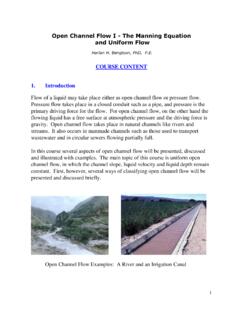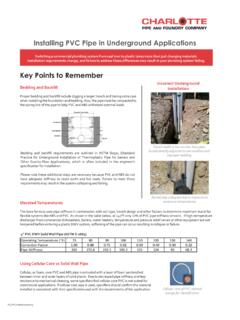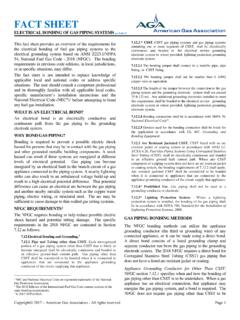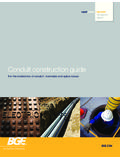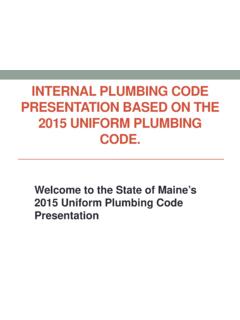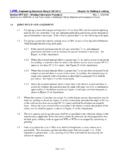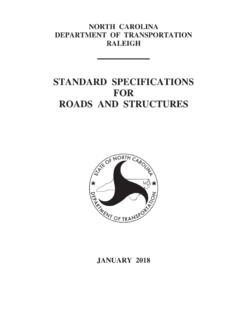Transcription of An Introduction to Petroleum Fuel Facilities: Piping Systems
1 J. Paul Guyer 2014 1 J. Paul Guyer, , Paul Guyer is a registered civil engineer, mechanical engineer, fire protection engineer and architect with 35 years of experience designing buildings and related infrastructure. For an additional 9 years he was a principal staff advisor to the California Legislature on capital outlay and infrastructure issues. He is a graduate of Stanford University and has held numerous national, state and local offices with the American Society of Civil Engineers, Architectural Engineering Institute and National Society of Professional Engineers. An Introduction to Petroleum Fuel Facilities: Piping Systems J.
2 Paul Guyer 2014 2 CONTENTS 1. Introduction 2. GENERAL REQUIREMENTS 3. ABOVEGROUND Piping 4. underground Piping 5. UNDERWATER Piping 6. Piping MATERIALS 7. WELDING CRITERIA 8. Piping CONNECTIONS 9. INTERIOR PIPE COATINGS 10. EXTERIOR PIPE COATINGS 11. SAMPLING FACILITIES (This publication is adapted from the Unified Facilities Criteria of the United States government which are in the public domain, have been authorized for unlimited distribution, and are not copyrighted.) J. Paul Guyer 2014 3 1. Introduction . This publication provides guidance for the design of new Piping portions of fueling Systems .
3 The criteria provided is intended to be general in scope except where specific criteria is necessary for given situations. 2. GENERAL REQUIREMENTS. Do not start design of any fueling system without first becoming completely familiar with General Design Information. DESIGN REQUIREMENTS. Ensure that Piping design, materials, fabrication, assembly, erection, inspection, and pressure tests for fuel Piping Systems are in accordance with ANSI/ASME Follow appropriate guide specifications for Piping design and materials selection. Use the following design criteria for Piping Systems : a) Unless otherwise specified by Owner, provide underground Piping Systems in and around areas subject to aircraft ground movements.
4 If approved by Owner, install Piping in concrete trenches. When trenches are employed, comply with NFPA 415. The use of common trenches for more than one utility is prohibited. Fueling equipment may be aboveground where it does not interfere with aircraft or service vehicle movements. Design all clearances in accordance with DoD Standard Design AW 78-24-28. b) In other cases, aboveground Piping is preferred where it is not aesthetically objectionable or not exposed to accidental damage, vandalism, blast damage, or sabotage. \1\ Small diameter ( 4 inches (100mm)) pipe associated with the aboveground storage of fuel/oil shall be single wall aboveground Piping . Exemptions may be granted by the Owner in cases where routing aboveground could result in catastrophic damage to the pipe.
5 If an exemption is granted, double-wall Piping must be installed in accordance with the paragraph titled Double-Wall Piping . c) The preferred method of routing aboveground Piping out of a diked area is over the top of the dike. However, avoid creating an inverted U on the suction side of a pump to J. Paul Guyer 2014 4 avoid an air trap. Provide high point vents and low point drains as required, refer to Facility Plate 019. d) Hydrostatically test new Piping Systems in accordance with ANSI/ASME During testing, disconnect system components such as storage tanks or equipment which were not designed for the Piping test pressure or protect them against damage by over-pressure.
6 Hydrostatically test Systems to times the maximum allowable design pressure of the ANSI/ASME Piping system flanges at 100 degrees F (38 degrees C), see Table 1. Test hydrant and direct aircraft fueling Systems and installation fuel pipelines with fuel that will be used in the pipeline or, at a minimum, a fuel with the same minimum specification flashpoint as the fuel that will be used when the Piping is in service. The temperature of the fuel, and the ambient temperature, shall be at least 20 degrees F (11 degrees C) below its flashpoint during the test. e) Testing with water requires Owner approval. When water is authorized for hydrostatic testing of fuel Piping , ensure that all water is removed from the Piping by either pigging the Piping , air drying the line, or by vacuum extraction.
7 F) Lay out Piping between piers and storage tanks, cross-country pipelines, and between bulk storage and operating tanks to accommodate pigging operations. Use long radius elbows, full port valves, barred tees, and provisions for the connection of temporary launchers and receivers. Give special consideration to smart pigging for single wall pipelines. g) When laying out Piping for single wall aircraft hydrant Systems , consider smart pigging/pigging in the design. For Systems with required Piping slopes and high and low level drains, provide long radius turns, and provide spool pieces for temporary pig launchers and receivers. Ensure valves are accessible for removal and replacement with spool pieces. Where it is more economical or practical to lay hydrant Piping flat (slope less than percent), provide the capability to rapidly clean the lines with a pig J.
8 Paul Guyer 2014 5 or to launch a smart pig. This includes providing long radius turns, full port valves, barred tees, and pig launchers and receivers. h) Provide thermal relief devices on all installed double block and bleed valves and other valves within the Piping system. Provide drain out with non-freeze valves at all low points of pipelines. HYDRAULIC DESIGN. In general, provide a hydraulic design with a velocity of 7 to 12 feet per second ( to m/s) on pump discharge and 3 to 5 feet per second ( to m/s) on pump suction at full flow. If project-specific conditions make it advisable to exceed these values, consult the appropriate Owner.
9 Consult with appropriate Owner for outlet pressure requirements. Design suction Piping to ensure that the net positive suction head required by the pumps is available under all conditions of operation. Consider the following factors in selecting pipe sizes: a) Operating requirements of the facility to be served. b) Capital cost of the pipe. c) Capital cost of pumping stations and attendant facilities. d) Operating cost of the system. e) Harmful effects of excessive velocity of flow including hydraulic shock and static generation. f) Fatigue failure caused by cyclic loading. Piping ARRANGEMENT. Wherever possible, arrange Piping in parallel groups to facilitate multiple use of supports, to minimize the amount of trenching for underground Piping , and to minimize the number of steps or stiles needed across pipe runs.
10 For underground applications, consider constructability when determining amount of spacing between pipes. Use the following criteria: a) Provide looped Piping Systems whenever practical. Loops add to the flexibility and reliability of the system, contribute to product cleanliness by making circulation possible, J. Paul Guyer 2014 6 and can be used to reduce the magnitude of hydraulic shock. Sectionalize loops by double block and bleed valves to provide verifiable isolation and to facilitate pressure testing. b) Between mains, install cross connections for flexibility of operation and as an auxiliary means of continuous operation in emergency situations.
